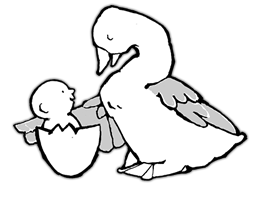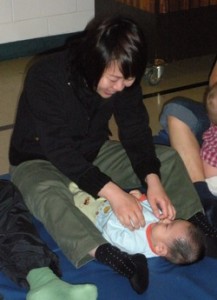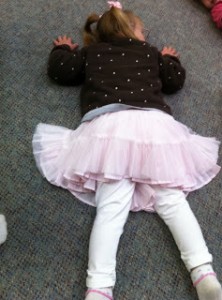by Lisa Hurrle
Rhymes are mini stories you can use wherever you are… at home, at the grocery store or even in the car!
Nursery rhymes have been passed down from one generation to the next for hundreds of years. Despite their often archaic language, they endure as part of our childhood lexicon. Rhymes are a powerful tool to build language, listening and imagination.
Regular use of interactive rhymes instills a love of language in children and provides a playful way for parents to interact with their children in everyday situations. In this way, rhymes can become touchstones that strengthen the parent-child relationship. Imagine how something so simple can accomplish so much!
A brief deconstruction of two of the rhymes that we use in the Parent-Child Mother Goose program will illustrate how they contain key elements to build positive family patterns, strengthen the parent-child bond create a strong foundation for literacy.
A Rhyme for Babies
In The Garden Snail, a parent slowly creeps up the baby’s body and then repeats the action quickly, ending in the tickle of a little mouse. This is a wonderful rhyme to use during diaper changing! The rhyme itself introduces many things: opposites (slowly and quickly), basic story sequence (beginning, middle and end) and actions that reinforce the meaning of the words (slowly and quickly). The rhyme slows down language and allows the baby to hear clearly the words and, since it is done face to face, the baby can watch how the parents’ mouth is working to make those sounds and words.
Once the rhyme is repeated enough to become familiar, the baby gains comfort from recognizing the rhyme and confidence from knowing what to expect – a joyful tickle at the end! The baby learns how to read the parent’s facial expressions and tone and the rhyme becomes a wonderful opportunity to communicate and experience a loving touch and playful tickle.
(With thumb and pointer finger, slowly climb up your child’s arm or leg)
Slowly, Slowly, very slowly
Goes the garden snail
(Start climbing up again)
Slowly, slowly, very slowly
Up the garden trail
(With all your fingers tickle up child’s body)
Quickly, quickly, very quickly
Goes the little mouse!
Quickly quickly, very quickly
Up into her house!
A Rhyme for Toddlers
Now let’s take an example of a rhyme we often use with our toddler groups. We are always amazed how a room of toddlers will hit the deck at the mere mention of “Sleeping Bunnies”. Not only is this rhyme fun for children, it is a great tool for parents to redirect children, when needed. The rhyme starts off as a lullabye and then changes pace into an active rhyme. Children gain practice transitioning from one state (a calm, quiet, pretend sleep) to another (active hopping).
For active toddlers, staying still and waiting for the cue to “hop” is no small thing. This rhyme helps them practice waiting and delaying gratification. In addition, some of the words like “merry” and “ill” are words that are not commonly used in everyday speaking. In fact many of the rhymes used in the program have words that even adults may be unfamiliar with like “cobbler” (someone who mends shoes) and “stile” (a set of steps that from a gate) and pawpaw (a fruit). In this way, rhymes can be vocabulary builders for children and adults alike!
Sleeping Bunnies
(Have child lie down. Parent rubs child’s back.)
See the little bunnies sleeping, sleeping until noon
Come let us gently wake them with a merry tune
Oh so still, are they ill? (big breath in to cue child)
Wake up bunnies, wake up now.
(Child gets up and jumps around)
Hop little bunnies, hopping, hopping
Hop little bunnies, hop, hop, hop
Hop little bunnies, hopping hopping
Hop little bunnies, hop and stop.
For such seemingly simple things, rhymes can work to achieve many complex results! Whether we understand the full range of what rhymes can accomplish or not, one thing is for certain: Rhymes have an enduring magic that will continue to make them a key part of the early childhood experience for generations to come.



Hi Deb! So great to hear that you’ll be enriching your preschool program with some of the PCMG material. What a great way to establish routines and integrate more rich language into your program! There is so much material to choose from but using a familiar song or rhyme consistently at transition times can really help cue the children (so much nicer than flicking lights!!) We use the “here’s a cup of tea” finger play to cue snack time, the clean-up song to signal the end of free play, and songs as an invitation to come to circle, or line up for gym etc. Also at circle time – how wonderful to be able to tell a story – it is so powerful to be able to look the children in the eyes and be able to connect with them, personalize the story and react to their reactions!
As far as rhymes go, one great discovery for me this year was the power of 10 fat peas! It never fails to settle the children down and prepares them to listen at circle or whenever:
Have the children sit down and clench their fists tightly, like pea pods, then slowly raise up the fingers, one by one, as the peas grow, then move arms out further and further, making a big circle in front of them, ending in a clap high above their head for the “pop” at the end. Here’s how it goes:
10 fat peas in a pea pod pressed
1 grew, 2 grew, so did all the rest!
They grew and the grew and they did not stop
Until one day that pea pod popped!
We do it 3 times. One at regular volume, then in a whisper, and finally with no words (all the children will be looking at you watching your mouth move for the cues) and then the challenge: to pop all together. Very fun! Good luck in September!
Hello ! This will be my first fall using the Mother Goose Parent/Child program with my preschoolers. I was wondering if you might be able to suggest some rhymes to share with a new preschool class. Also, my class (children & parents), being english language learners, I would like to promote the English language through rhymes with movement, especially related to routines/expectations in the classroom. Would love to hear what you might have to share. Thanks, Deb